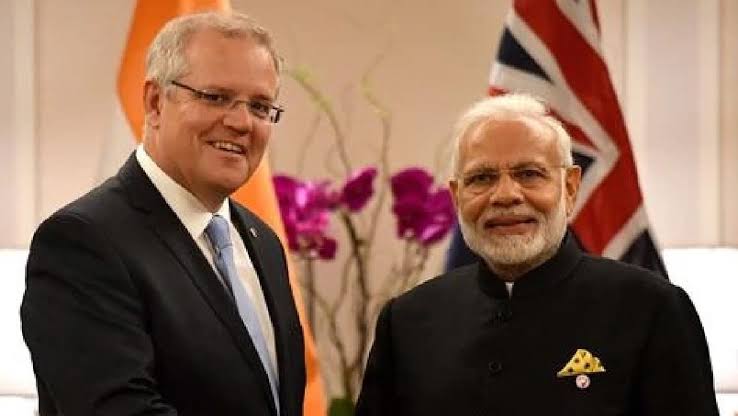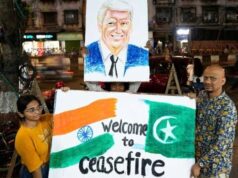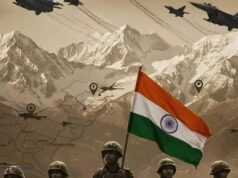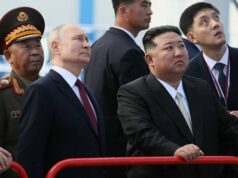India – Australia defence ties: From World War 1’s Gallipoli to Galwan, and beyond

Battlefields have the unique ability to unite people and bring them closer in more ways than one. Indian and Australian troops first fought together in 1915 in the trenches of Gallipoli against the Turks and thereafter against the onslaught of the Afrika Korps led by Rommel during the siege of Tobruk in 1941.
Both countries have also been holding a Two plus Two Defence and Foreign Secretary-level dialogue since 2018.
BY
MAJ GEN JAGATBIR SINGH ( RETD )
Battlefields have the unique ability to unite people and bring them closer in more ways than one. Indian and Australian troops first fought together in 1915 in the trenches of Gallipoli against the Turks and thereafter against the onslaught of the Afrika Korps led by Rommel during the siege of Tobruk in 1941.
They have also fought shoulder to shoulder in the jungles of Malaya and in the Far East
These experiences forged extraordinarily strong bonds between soldiers facing unspeakable horrors and enduring unimaginable suffering together.
War removes all social barriers whether cultural, linguistic, and religious or race as soldiers fight together to overcome insurmountable odds. What matters are honour, bravery and grit, and this leads to mutual respect and enduring relationships.
Apart from shared experiences on the battlefield, the two countries also share a common love for cricket and sporting ties are second only to those of war. With this background why is it that our relations with Australia have seen both centrifugal and centripetal forces at play and now will our common concern of countering China result in closer cooperation between our nations?
Pre partition, both India and Australia were part of the British Empire, while India was ruled by the British, Australia was a self governing dominion. However, Australia’s “White Australia” policy that effectively stopped non European immigration into the country and contributed to a racially insulated white community was a thorn in our relationship. This policy was gradually dismantled over the years and finally ended in 1973.
Today, Australia prides itself on being a multi cultural society and in a population of 25 million over 1.2 million are ethnic Chinese whereas Indians are nearly 7 lacs representing over 2.8 % of the population. Indians are however the highest growing migrant community.
The first issue post-partition was the status of the Andaman and Nicobar Islands. The British thought that their non-inclusion in India would benefit them by keeping their dominance in the region as well as keep India in check. Whereas, Australia wanted Britain to secure long term leases for naval and air facilities in the event Britain could not retain the islands. The Andaman & Nicobar Islands became part of India in 1950. Thereafter, the paths of India and Australia diverged with the cold war. Australia is firmly aligning itself with the US and India following the path of non-alignment.
Though, in November 1963, Australia participated in Exercise Shiksha, an air exercise which validated our air defence systems. This Exercise was held as an outcome of Prime Minister Nehru asking President Kennedy for assistance against China in November 1962. Of course, the exercise was conducted to show solidarity against the Chinese and convey an appropriate message.
Another irritant in the relationship occurred in 1990, a period of heightened tension in Kashmir when Australia sold 50 Mirage III aircraft which had been decommissioned by the Royal Australian Air Force (RAAF) in 1988 to Pakistan. These were Australian built aircraft and were subsequently upgraded under the Retrofit of Strike Element ( ROSE ) programme. India viewed this as a destabilizing threat but Australia never appreciated our anxieties. Subsequently, they have been involved in tests of their Ra’ad cruise missiles which can carry both conventional and nuclear warheads.
The last major issue that cast a shadow on our relationship with Australia was its reaction to the nuclear tests conducted by us in Pokhran in 1998. They not only condemned it in strong terms but also suspended all bilateral Defence ties including recalling Australian officers attending courses in India, doubling military aid to Pakistan which it cancelled after Pakistan conducted its nuclear test and of course banning the sale of uranium to India because India was not a party to the nuclear Non-Proliferation Treaty (NPT).
This ban was finally lifted after the signing of the Civil Nuclear Cooperation Agreement in September 2014 during the visit of Prime Minister Tony Abbott to India. Uranium exports to India by Australia finally commenced in September 2017 when Australia made a special exception for India as the first country which is not a signatory to the NPT with which it trades in uranium.
There are differences in the nuclear paths taken by both countries. India has no option but to weaponize in view of the fact that two of its neighbours possess nuclear weapons, whereas, Australia though having 31 % of the world’s uranium reserves is protected by being under the US nuclear umbrella. It is also a signatory to the Treaty of Rarotonga which ensures a nuclear-weapons-free zone in the South Pacific and is obligated to ensure that nuclear materials are exported only to countries safeguarded by the NPT.
Apart from the issues listed earlier, Australia has its own reasons regarding the slow trajectory and shallow depth of its relationship with India. The two major issues that come to the forefront are the view in its strategic circles that India due to our hostile neighbours is mainly a Continental Power, whereas Australia would like to see us being a more assertive maritime power.
The other is that in spite of India’s economic rise, we still have a large population which is below the poverty line and thus need to spend heavily on food, health and education subsidies which results in a decrease in our Defence expenditure. While these two issues are realities given our unique geographical location with a revisionist Pakistan and a coercive China, unresolved borders, ongoing proxy war and large population, there is no shying away from the fact that both countries though geographically at two extremities of the Indo – Pacific are the largest maritime powers in the region and shoulder the responsibility of its security.
Australia finds itself at the crossroads today. It depends on the US as far as its security needs are concerned and at the same time China is its biggest trading partner. The Chinese – Australian trade in 2018-19 stood at A$ 235 billion, accounting for nearly 26 % of its total trade, with the balance of trade firmly in Australia’s favour whereas with India it is A$ 30.3 billion, which makes us its eighth-biggest trading partner, accounting for only 3.4 % of its international trade.
There is no doubt that China’s growth has contributed to Australia’s prosperity. So far it has been able to decouple its security and economic concerns, but with increasing belligerence being displayed by China and the responsibilities of security of the Eastern Indian Ocean, Australia will need to make a tough choice between trade and security.
There has been considerable progress in bilateral Defence ties; Australian officers have been attending courses in India regularly. Shri AK Antony was the first Indian Defence Minister to visit Australia in 2008, thereafter there have been a series of engagements and agreements mainly due to the shared values of both countries. We have been Strategic partners since 2009. A Framework for Security Cooperation was also agreed during the visit of Prime Minister Modi to Australia in November 2014.
With a focus on expanding maritime cooperation AUSINDEX, the first bilateral exercise commenced in 2015 and is undoubtedly a display of increased collaboration. Both countries have also been holding a Two plus Two Defence and Foreign Secretary-level dialogue since 2018.
In March 2019, Australia along with Bangladesh also co-sponsored a resolution in the UN Security Council for blacklisting Jaish- e –Mohammed ( JeM ) Chief Masood Azhar as a global terrorist.
The greatest impetus to raise the bar on the content and form of engagement has come in the midst of the Galwan standoff, when a virtual summit was held between Prime Minister Modi and Prime Minister Scott Morrison on 04 June resulting in the signing of two Defence Agreements. These were the landmark Australia – India Mutual Logistic Support Agreement and the Defence Science & Technology Implementing Arrangement.
The agreements commit both countries to deepening military integration, including joint exercises and grant access to each other’s bases for logistical support. The joint statement issued at the end of the summit stated “as two Indo – Pacific countries, India & Australia have an enduring interest in a free, open, inclusive and rules-based Indo – Pacific region.
Today, neither country views each other as a security provider. Both have limitations as far as the military projection of their power is concerned, although both their military capabilities and capacities have been increased. The common thread is that both nations acknowledge the US as the dominant power to balance China in the Indian Ocean Region. It is therefore imperative that we strengthen our relationship which has traversed a long way since our lowest ebb in 1998.
If you go by the current indications, it is almost certain that Australia will be invited to attend Exercise Malabar, which is likely to be held at the end of the year. If this happens, it will be the first time all members of the Quadrilateral Security Dialogue (Quad) will be participating in a maritime exercise since 2007. Hesitant steps need to transform into firm strides.
Incidentally, all four countries have a level of friction with China at the present moment although the issues and degree vary. The message conveyed to China will be of a unified commitment and resolve to counter China’s belligerence. The Global Times has stated that “bolstered by Canberra, it will help India expand its influence in the South Pacific via the straits of Malacca”.
Since the outbreak of COVID-19, there has been a recent deterioration in relations between Australia and China, and Prime Minister Scott Morrison has called for an independent international inquiry into the origin of the pandemic. China reacted by increasing tariffs on some products and threatened other forms of economic coercion.
While COVID-19 has been the catalyst for the deteriorating Australian relationship with China, the events in Galwan only accelerated the bilateral movement of India and Australia towards each other primarily because of an increasing manifestation of shared security concerns.
The alignment of these security concerns and common apprehensions of China’s growing expansionism and assertiveness in the region leaves no doubt that the future for both countries lies in consolidation and cooperation to contest China’s rise. There can be no more hedging as far as China is concerned.




